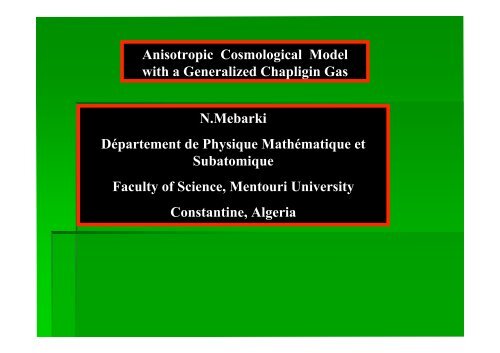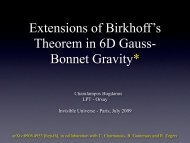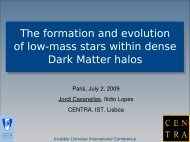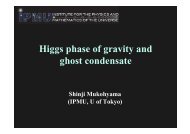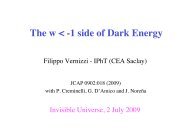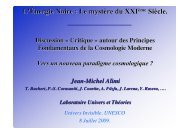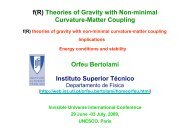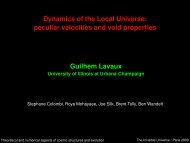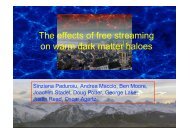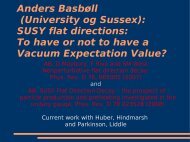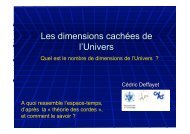Anisotropic Cosmological Model with a Generalized Chaplygin Gas
Anisotropic Cosmological Model with a Generalized Chaplygin Gas
Anisotropic Cosmological Model with a Generalized Chaplygin Gas
You also want an ePaper? Increase the reach of your titles
YUMPU automatically turns print PDFs into web optimized ePapers that Google loves.
<strong>Anisotropic</strong> <strong>Cosmological</strong> <strong>Model</strong><strong>with</strong> a <strong>Generalized</strong> Chapligin <strong>Gas</strong>N.MebarkiDépartement de Physique Mathématique etSubatomiqueFaculty of Science, Mentouri UniversityConstantine, Algeria
Motivation:*The observed anisotropy of the microwave cosmic radiation.This anisotropy is of a dipole type, the intensity of the radiationis maximum in at one direction and minimum at the oppositedirection.*It is known that this anisotropy can be explained if we useRobertson_walker metric and take into account the movment ofour galaxy <strong>with</strong> respect to distant galaxies of the universe.*A small anisotropy is expected ,however due to the anisotropicdistribution of galaxies inspace.
Mathematical FormalismA <strong>Generalized</strong> FRW model<strong>with</strong><strong>Generalized</strong> Chapligin gasTaking into consideration the anisotropic structure of fieldswhich are dependent on the position and the direction (velocity)solutions of: Friedman-like equat., Raychaudhuri equat. and CMBtemperature estimation are affected by presence of anisotropy
Finsler GeometryFinsler geometry may be considered as a generalizedRiemannian .can be considered as a physical geometry on which matterdynamic takes place while Riemannian geometry is thegravitational geometry.connect the Riemannian metric structure of the space-time tophysical vector fieldsA long range vector field of cosmological origin is consideredin relation to a physical geometry where the Cartanconnection has a fundamental role
an electromagnetic field or a gauge vector field may emergeout by a physical source of the universecan be incorporated into the geometry causing an anisotropicstructureSo the geometrical anisotropies are caused byinternal variables.The variation of anisotropy is expressed in terms of theCartan torsion tensor of the Finslerian manifold
A Finsler spacea metric spacemetric functiondefined by a norm F (on a tangent bundle instead of definingan inner product structure on it)norm is a real function F(x,y) of a space-time point and atangent vector Y belonging to T x M which plays the role ofan internal variableY dependence characterizes the Finslerian field: combined <strong>with</strong>concept of anisotropy causing deviation from Riemannian geometry
The induced Finslerian metric tensor gives rise to theosculating Riemannian metric g (x,y)We can introd. a Lagrangian LL = F(x,Y)Geodesics of 4-dim space-time are produced by a Lagrangianof the Randers-type metric function:F(x,Y )= $ + U"Y"$ =U"( g( x)µ!Yµ= KˆY"µ)1/ 2&(x)gYµ!µ2a= diag(1,%1%krµdx=ds2,%a2r2,%a2r2sin2# )......... k=0, ± 1
Important information about the anisotropy is encoded into thecomponent U 0(t), so the vector Kˆ !Choice of connection and curvature: metric of Finsler space canbe directly calculated from the metric function F:2 21 ( Fgˆµ!( x,Y ) =µ !2 ( Y ( YF 1= gµ!+ ( UµY!+ U# 4#( , ) ˆ""% x Y = K '(x)Y = U ( x)YgYUµ!µ!F(x,Y )# = ( g2a= diag(1,&1&krµdx=ds= ( B + µ t,0,0,0)µ!= # + UYµY"µ)"1/ 2Y"2,&a"2r2,&a2r!2Yµsin) &2% ( x,Y )Y3#$ )......... kµY!+ U= 0, ± 1µU!
In the framework of Finsler geometry , the fourvelocity vector is treated as independent variableIn the framework of Finsler geometry,the flatrotation curves of spiral galaxies can be deducednaturally <strong>with</strong>out involving dark matter
*Under weak field assumption: we can approximate Finslerianmetric as a perturbation of the FRW metric since in generalrelativity a weak vector field in a space (e.g a magnetic field)can be treated as a first order perturbation of the Riemannmetric tensor.We consider a convenient Finsler metric to approximate thegravitational theories. This metric is reffered as osculatingRiemannian metric( x)gˆ( x,Y )rµ!=µ!connected to the Riemanian one <strong>with</strong> the followingosculating affine connection A ! "µ(x)
*The equation of the geodesics is given by :d2dsx2µ+Aµ"!( x)Y"Y!=0*Under the assumption that the vector fieldsatifies the relationthe Finslerian!!Y; "= 0Y-covariant derivative and the Cartan covariant derivativeof an arbitrary vector field!B ! ( x,Y ( x)B!( x,Y ( x))= B!( x,Y ( ))are equal.;" x#"C000µ ==2CU20000,0
Cartan’s covariant derivative :B$ B### # !!( x,Y ( x))= B" "+ A!"( x)B % G& ,! "$ YThe Cartan connection components :A$#µ( ˆ $ $ ! $ ! F $"!( x)= & #µ % C !µ G#% C #! Gµ+ g C#µ!G")( x,Y ( x))"
•A Finsler space is a Riemanian space if and only ifC ijk= 0whereC ijkis the torsion tensor defined by:Cijk=12! gˆ! YijkFor a Finslerian fieldB !( x,Y ( x)the!-covariant derivative has the form:"" " !;# ( x,Y ( x))= B,#+ A!#( x BB )
1))(((0))()(ˆ)()()(1)(121))(,()ˆˆˆ(ˆ21))(,(ˆˆ21))(,)(( ˆ)(ˆˆˆˆˆˆ0)(3)(3)(!!!µµ!"µ#µ#""#µµ#""µ#µ#"µ#"$%%$µµ#µµ#%$"µ%&$%µ"%&%"%µ&"µ&&"µ!%#%"µ!%µ%#"!"µ#!"#µ!"µ#!µ!#µ#µ#µ#!$'$$$UxxxxKxUYgSUYYSUgSxYxCggggxYxYYGYGGxYxGCgFGCGCxAAAAAAARRRRgRxjkrrkjrjkirkji=(+ )* (((=+,-./011=1 )+ ))=22=))=+112=1+1 )= )==
Field equations in both formalisms (Finsler geometry):Rˆ 1ˆ ˆ =2!"$ g!"R 8# GT!"ˆRˆRˆRˆRˆ00112233a!!= 3[( ) +a1= "1"Kr= " r= " r22[ aa!!+sin2342a!( ) µ ]a[ aa!!+2a!2![aa!!+2a!2+ 2K2a!2+ 2K+114+ 2K+11aa!µ ]4aa!µ ]+11aa!µ ]4
In Finsler Geometry:Some aspects of Finsler GeometryQualitative theoretical studiesExample N°1Consider 1st FRW equat.in Riemmanian Gemetry2 1H ! + H = ! ("+ 3P)6Notice that if:! No acceleration! + 3 P = 0 a! = 09 2W exp( # )Sol: a!!= 16! 03exp( # ) " (1 + W )42 3 1H ! + H + µ H = ! ("+ 3P))4 6" = !34a!!0 ! accelerationWH ( t !0t 0W =µH 0)
Conclusion N°1With the same fluid Finsler and Riemanian geometry gives differenteffects
Example N°2We want an accelerating universe:2 " 3 1H ! + H = µ H " (#+ 3P)! 04 6Assume1# ( $ + 3P)=6W " µW ! 034WHif µ = 0H ! 2 3+ H = ( W ! µ ) H4RiemanianGeometryDeceleration3! = # ( W # µ )"042Sol a! # D exp( "#t)H0=! 0D = exp( ! t0)Ha D exp( "#t)" 10+ !acceleration
Conclusion N°2With the same fluid <strong>with</strong> Finsler and Riemanian geomertry one can gofrom deceleratio to acceleration phenomena
<strong>Model</strong> N°1Ifwhere<strong>Generalized</strong> Friedman likeequations:! tot+ 3 Ptot= 0H!H= " H22++ Hµ+34Ka2Hµ=!tot3"tot="m+"chapPtot=Pm+PchapPPm=chapw"= #m"A!chap
Exact solutionsH ( t)3= " µ H43! = " µ t40H0exp( ! "!(exp(!"!00)) " 1)"3µ4
)431))(exp((34)( 000µ!!µ""""= Hata0431))(exp()exp(16900002!""""=µ####µHHaa!!0)431))(exp())((exp(1)( 0000!""""""= µ#### HHtq!!"#$$%&''=='''''=12132)431))(exp())(2(exp(122200020qqsqHHr µ((((Scale factoraccelerationdecelerationparameterStatefinderparameters
w = 0!""chapchapmmAPwP= #=If20000000211431))(exp(43)exp(41)exp(43)()(3)()(3)(31!"#$%&+''!"#$%&++'''=()*+,-'=()*+,-== 'µ..µ....µ..././.00HHHHggAggAgPmchapchapExactsolutions
0,080,07mu/H 0=-0.010,060,05H/H00,040,030,020,010,0 0,2 0,4 0,6 0,8 1,0theta-theta 0
0,0220,020mu/H 0=-0.01a(t)0,0180,0160,0140,0120,0100,0080,0060,0040,0020,0000,0 0,2 0,4 0,6 0,8 1,0theta-theta 0
2,00E+008mu/H 0=0.011,50E+008phochap1,00E+0085,00E+0070,00E+0000,0 0,2 0,4 0,6 0,8 1,0theta-theta 0
q-120mu/H 0=-0.01-140-160-180-200-220-240-260-2800,0 0,2 0,4 0,6 0,8 1,0theta-theta 0
8000070000mu/H 0=0.016000050000r400003000020000100000,0 0,2 0,4 0,6 0,8 1,0theta-theta 0
0,0002mu/H 0=0.010,0000-0,0002-0,0004-0,0006Pchap-0,0008-0,0010-0,0012-0,0014-0,00160,0 0,2 0,4 0,6 0,8 1,0theta-theta 0
-40mu/H 0=0.01-50-60S-70-80-900,0 0,2 0,4 0,6 0,8 1,0theta-theta 0
If$Ptottot= $= P+ !(t)" !(t)1!(t)= g(# )32$m= g(# )3P = 0mmmInduced <strong>Cosmological</strong> Constant
0,0016Induced Lambda0,00140,00120,00100,00080,00060,0004mu/H 0=0.010,00020,0000-0,00020,0 0,2 0,4 0,6 0,8 1,0theta-theta 0
!!!!!!!!µµ+""++#+"+=$12010)(112010)43(31)(1)()43()(131 20HAHHHM
0,3300,3250,320OmegaM00,3150,3100,3050,300-0,10 -0,08 -0,06 -0,04 -0,02 0,00mu/H 0
If"m* 01A)3(&'34µH2(1 + )0H0%#$1+!!
mu/H 0=-0.050,900,850,800,750,700,650,600,550,500,450,400,350,300,250,200,150,100,050,00allowed region of A0,1 0,2 0,3 0,4 0,5 0,6 0,7alpha
alpha=0.41,000,950,900,850,800,750,700,650,600,550,500,450,400,350,300,250,200,150,100,050,00-0,16 -0,14 -0,12 -0,10 -0,08 -0,06 -0,04 -0,02 0,00allowed region of Amu/H 0
" ! 0<strong>Model</strong> 2~"~"~PP+==$ =~3P"P= #12"(=+ $# $A!"0#"A!)
!!!!"#$$$$%&++=+= '= ''= 'µµµ(((µµ43ln43283)sinh()exp(83)(430002HHtBBttHHHH !
1)))(exp(243(34)( 00!+!= "µµ Hata)4exp(1)()sinh24exp(132)213(1)()sinh24exp(223!!!!!"+""=""="==qrsaHar!!!)sinh()exp(329 2!!µ=aa!!
Conservation of momentum-energystress tensorIn FinslerGeometryA 1!= #( 3H+ µ )!+ 3 ( H + µ )"! 2Can be rewritten asNumericalsolutions2 $2! " "($1+!3 ! A + "$$=+ 112= # 3H# µ= A(3H(1 #!)+ µ! ))
mu/H 0=-0.021,151,10abs(Pchap )1,051,000,950,900,0 0,2 0,4 0,6 0,8 1,0theta-theta 0
1,20mu/H 0=-0.021,151,10density rho chapligin1,051,000,950,900,850,800,0 0,2 0,4 0,6 0,8 1,0theta-theta 0
mu/H 0=-0.02Lamda2,122,102,082,062,042,022,001,981,961,940,0 0,2 0,4 0,6 0,8 1,0theta-theta 0
<strong>Model</strong>3Friedman like equats.8 !G = 1P = #A!"2 3 1H ! = " H " Hµ " (!+ 3P)= S(H,!)4 6µ!= " 3 H (!+ P)" (2!+ 3P)= Q(H,!)2<strong>Generalized</strong>chapligin gasDynamical System
)7(134),(6)(1),())ln(31exp(6),(49),(00000000!µ"!"!!"µ"""+= #$+= #$+#= #$= #$HQHSAAHQHSHH43)1)ln(3exp(00µ!"#+#HACritical point
Near the critical point one can write:(1 + !)ln(3A)9 µ! " $ # ("# exp( )) # µ ( H # 3 )6! + 1 4 4µln(3A)!H!$ # (13 + 7!)("# exp( )) # 6Aexp(# ln(3A))(H4! + 11+!# 3µ)4
),(),(),(),())ln(31exp(66)(1)exp()exp()exp()exp(00002200001121222111022110HSHSKHSHSKAAtKCtKCHHtCtCHH!!"!!"##"#"""""!!!!$% $=$% $=+%& %+& %++&++&The solutions are:
0))ln(31exp(66)(1)(0)())ln(31)exp((1)())ln(31exp(6)7(134496)(12!"#$%&'+(++= ()++(+*"""#$%%%&'+((+((+(=AAMTrOAAMDetAAM+++µ++++++µµ+Linearized stability matrix M:Stable criticalpoint),( 0! 0 H
Distinct realEigenvalues: nondegeneratecritical pointNegative eigenvalues: critical pointis a sink (all the solutions will dyeat critical point)%%%1212(1 + &)$ #6$ # 6Aexp(#%1" %% ! 0! 021&ln(3A))+ &
From Numerical solutions of dynamical systemGet
400mu/H 0=-0.01ln(density rho chap )30020010009,0 9,5 10,0 10,5 11,0 11,5ln(t)
0mu/H 0=-0.01-20ln(abs(Pchap )-40-60-80-1009,0 9,5 10,0 10,5 11,0 11,5ln(t)
Further Aspects
))3(1(21411))(3(2)3(1))3(1(6143)(3)2(122PtaaaaaaPtaaaaaaµ!µ""µ!µ""+#=++++++= #+##!!!!!!!!0)2(33)(3 =++++ !µ!! PPaa!!Friedman_like equations in: != 1+)( RRfAnisotropies
)()()()()()()()()()()())()()(()(82765243321tHttHttHtHtHttHtttHttt!!"!!!!"!!"++=++++=!!3827161095874653432211)()()()()(bbbtddttddttddttddttddt===+=+=+=+=+=!!!!!!!!Rewritten as equat. Dynamical system
µ!!µ!µ!!µ!µ!!!µ!!µµ!3)521523(15209415)563019(562213016130933535113545354358565832110987654321= "+= "==+= "+= "+""= "= ""+== ""+= "=++= "bbbdddddddddd
Study of stability issue ensures that no future singularity willbe present in the solution.We have found the followingcritical pointsxy00==00orxy00= "=y0" !( b12!23yb01+ !2+b3)xy00= "=y0" !( b12!23yb01" !2+b3)
)(4 113532122123321311241!!!!!!!bbbbbbbb"#"= ##"=#""=#Where:
32101302002)(!+ !" !=+= "ybbybyx30222121504203021202111222112112223bybMbMyyxMyMMMMMM+==+++=+=!!"#$$%&=''''''00det22!"TrMMStability Matrix:0.10.010!! "#µH
Eigenvalues:""12==! TrM! TrM22+ ( trM! ( trM222222! 4det M! 4det M22))1/ 21/ 2"!00Critical point is a saddle point
For:xy00==00M1=&'$% b110 #!b3 "detTrMM11! 0" 0!1="1!2= b3
A general fourth order theory of gravity in four dimensions isgiven by the action: In Finsler geometry <strong>with</strong> a FRW like metric,the action reduces to the point like one:can be the action in:[ ]f RA = " d4x ! gˆ( ˆ)+L matter12&(% gˆLˆm) &(% g Lm) 1% gˆTˆ[( ) ˆ"#=% &"#!= % g $ P Y"#m+m µY!% Pmg& gˆ&(&gˆ) 2!µ!]
the action reduces to the point like one:can beThe actionInA = ' dt& L a a Rˆ,Rˆ!( , !,) + L$%matter#!"L=!L(a,a!, Rˆ,Rˆ)!52= ! a3( faa ! µ f " ! 2a! Rf ˆ3P eff")+#6a(1! ) a!22f" + 5(1 !3#) aa !42Rf ˆ!"" ! 5K(1!#) af"
)]44)(2(ˆˆˆ)4()ˆ[2(4]ˆ31)(219[)(18222aaaKaaffRRfRfaaRffRffaaPfGPmeff!!!!!!!!!!++!"!!!"!!"!!"!""!!+!"!"=#µ#$)])(43(1)(47)(1)(1)6[(ˆ22aaaaaKaaR!!!!!µ!! "++"+"=B µt! +=
<strong>Generalized</strong> Raychaudhury equation:From fluid motion a congruence (collection) of particles having timelike 4-velocityY aas they fall under their own gravity. it could suffer thefollowing effects:•(a)Expansion/Contraction of volume which is givenby the divergence OfY athat is"! ˆ # #= Y # $ C "# Y !2; = 3 H +Hµ
•(b) Shear, distortion in shape <strong>with</strong>out change in volume, is givenby a symmetric tensor which is trace free (for no change involume) and orthogonal toY aand hence it is defined by:1$ ˆ!"= Y! "Y!Y"# ˆ hˆ( ; )% !( )%3!"•(c) Rotation/Vorticity, rotation <strong>with</strong>out change in shape and it isgiven by an antisymmetric tensor orthogonal toY aˆ ="! [";!] ["! ]# Y $ Y!Y
•(d) Acceleration due to non gravitational force like pressure gradientis a vector defined by!Ya= Ya;bYbwhich is orthogonal toY a*The trace of the tidal tensor (Raychaudhury scalar)(if positive we call it the strong energy condition)ˆ $ #R Y Y = 4"G(! +$#3P).
)]4347()26[()](3)(3)(9))()([2()(1ˆˆˆˆˆˆ31ˆˆˆˆˆˆˆ3ˆ)(ˆ)3(4ˆˆˆ31ˆ220222][];[)();(222;;;;;;;,,222HaKHUHaKHHfffHfffYYghYYYhYYYHHYCYYYYYYYYYPGcbbaaccaacca!!!!!!!!!!!!++!++="""!""!""!"!"# =!=!=!!===+=!=+!=+ # ++++!= !$$$$$$$$$$$%&'%%%'''µ&()%'&&***+*++*+**+*++*+**+*+*+*+*+++********
*If we define a new Hubble constantHˆ2=H2+Hµ+ ## =$ =13 f "($ )6[( H!1[2(+ 2H2f( $ )+Ka! $ f "($ )) ! 3H$! f2H )! U0Ĥ such that : )]7(4H2""($ )]+Ka2+34H!
*The shear tensor measures any tendency of an initially spherical ball ofmatter to become distorted into an ellipsoid shape. The vorticity tensormeasures any tendency of nearby world lines to twist about one another*The right hand side of Raychaudhuri’s equation consists of two types ofterms:1-terms which promote collapse:-expansion scalar-shearingPositive trace of the tidal tensor2-terms which oppose collapse:-vorticity (corresponding to Newtonian centrifugal forces)Positive divergence of the acceleration vector
usefulremark" ˆ&ˆ 23Hˆ &crit=8'Gˆ K"&% 1 =ˆ 2 2H a& $ ˆ & ! " ˆ $ 1 ! K$0&#ˆ &=critcrit& = ˆ &&ˆ &critcrit! " ˆ&&! " ˆ# 1 ! K#0&= 1 ! K=0*The value ofµ and the form of f (! )influence or affect the type of special curvature.
Conclusions:The goal is:• Undrstanting of Finsler geometry and first contact <strong>with</strong>cosmology. First step towards more realistic study.• Show some motivations for this geometry• Study some simple theoretical aspects and compare <strong>with</strong>Riemanian geometry case• Finsler Geometry is a simplest generalization of RiemanianGeometry and can make important changes in studying thevarious cosmological parameters (Some simplest examples areshown explicitly)• Discussed also the stability of the solution through two examples• We have constructed a Raychaudhury like equation <strong>with</strong> an f(R)like action• Definition of A modified Hubble constant and critical density(Crucial to determine the type of structure of the space time.)• Some cosmological parameters are obtained in the case ofgeneralized Chapligin gas etc....
Perspectives:Quantitative study + More realistic model +More contact <strong>with</strong>observations and phenomenology has t(under consideration)
Thank You


